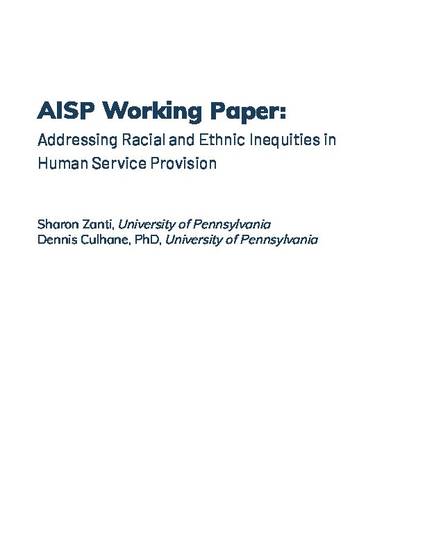
Unpublished Paper
AISP Working Paper: Addressing Racial and Ethnic Inequities in Human Service Provision
AISP Working Papers
(2021)
Abstract
Equity assessments, like those described in this working paper, have historical roots in the Civil Rights movement. As part of demands for equitable access to jobs, resources, and services, communities of color and Civil Rights advocates pressed public and private institutions to document the representation of racial and ethnic groups (National Archives, 2016). Corrective action plans were used to develop clear strategies to redress inequities and hold institutions accountable to change. Affirmative action policies reinforced these strategies by
requiring certain groups, such as federal contractors, to develop numerical targets and timelines to correct for underutilization of services by marginalized groups (Legal Information Institute, n.d.).
Human service agencies are now being called upon once again to address inequities within their programs. In January 2021, President Biden signed the Executive Order on Advancing Racial Equity and Support for Underserved Communities Through the Federal Government, which requires federal agencies to identify methods for assessing equity within federal programs and to engage communities historically underserved or discriminated against in these programs (Exec. Order No. 13985, 2021). This working paper strives to build upon the aims of the Civil Rights movement to help human service agencies estimate and respond to racial and ethnic inequities in their service provision. The urgency of this work is underscored not only by the executive order, but also by the long overdue social unrest around racialized violence and inequity in the U.S. and the stark racial disparities in experience and outcomes of the COVID-19 pandemic.
The following sections of this paper outline three phases of work—performing a gaps analysis (measuring gaps between need for and current availability of services), interpreting the gaps analysis (assessing root causes of the problem and strategizing responses), and co-creating an equity plan (determining next steps and implementing strategies to correct for inequities). Importantly, community organizations and those with lived experiences of the systems under consideration need to be engaged throughout this entire process. See A
Toolkit for Centering Racial Equity Throughout Data Integration for more (Hawn Nelson et al., 2020a). In addition, the general process provided here will need to be customized based on the social issue of interest, local context, available data, and resource constraints. Drawing upon multiple data sources, types of expertise, and stakeholder perspectives is highly recommended in order to robustly assess and respond to inequities in service provision. Altogether, these methods can inform social policymaking and support human service
agencies in more equitable resource allocation and service provision.
Keywords
- racial equity; human services; needs assessment
Disciplines
Publication Date
October, 2021
Citation Information
Zanti, S & Culhane, DP (2021). Addressing Racial and Ethnic Inequities in Human Services Provision. Philadelphia: University of Pennsylvania AISP Working Paper Series.
